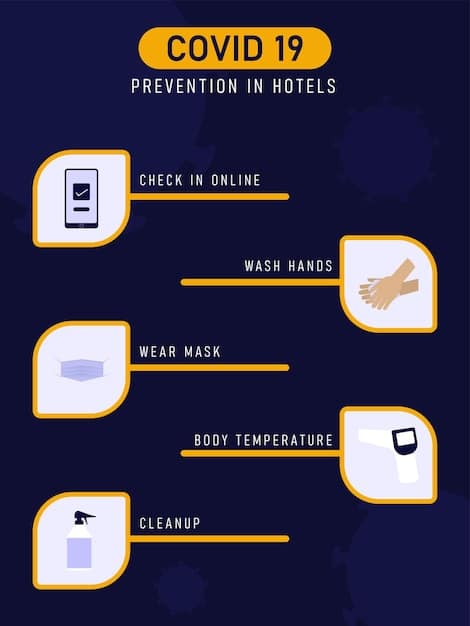Secure Coding Practices: Your Ultimate Cybersecurity Guide

Secure coding practices are essential for preventing vulnerabilities in software development, encompassing a range of techniques and principles to mitigate risks and enhance overall cybersecurity.
In the realm of software development, secure coding practices are not merely an option but a necessity. They represent the foundation upon which robust and resilient applications are built, safeguarding sensitive data and systems from potential threats.
Understanding the Importance of Secure Coding
Secure coding is pivotal in today’s digital landscape. A single vulnerability can lead to catastrophic data breaches, financial losses, and reputational damage. Let’s delve into why secure coding is a cornerstone of cybersecurity.
By implementing secure coding practices, developers can proactively identify and address potential weaknesses in their code, making it significantly more difficult for malicious actors to exploit vulnerabilities.

The High Cost of Insecure Code
The ramifications of insecure code extend far beyond mere inconvenience. Think about the Equifax breach, which exposed the personal data of millions due to a known vulnerability. Or consider the countless small businesses shuttered after ransomware attacks. The financial and reputational toll can be devastating.
Ignoring secure coding practices is akin to leaving a door unlocked in a high-crime neighborhood. It’s an invitation to potential attackers, making it far easier for them to gain unauthorized access to sensitive systems and data.
Secure Coding as a Proactive Measure
Rather than simply reacting to threats as they arise, secure coding practices empower developers to anticipate and prevent potential vulnerabilities from ever making their way into production systems. It’s about building security in from the ground up, rather than bolting it on as an afterthought.
- Reduced Risk: By proactively identifying and fixing vulnerabilities, developers significantly reduce the risk of cyberattacks.
- Lower Costs: Addressing security flaws early in the development lifecycle is far less expensive than dealing with the aftermath of a data breach.
- Enhanced Reputation: Demonstrating a commitment to security can enhance a company’s reputation and build trust with customers.
- Compliance: Many industries are subject to regulations that mandate secure coding practices and data protection measures.
In conclusion, understanding the importance of secure coding is the first step toward creating resilient and reliable software. By embracing secure coding principles, organizations can protect themselves from a wide range of cyber threats and safeguard their valuable assets.
Essential Principles of Secure Coding
Secure coding isn’t just about following a checklist; it’s about understanding the underlying principles that guide the development of robust and secure applications. Let’s explore some of the fundamental principles that should inform every line of code you write.
These principles are crucial for anyone involved in software development, testing, or security. By adhering to these concepts, developers can create more secure and reliable software systems.
Input Validation: The First Line of Defense
One of the most critical aspects of secure coding is input validation. This involves carefully scrutinizing all data that enters your application, ensuring that it conforms to expected formats, lengths, and types. Failure to validate input can open the door to a wide range of attacks, including SQL injection, cross-site scripting (XSS), and buffer overflows.
By implementing robust input validation measures, you can significantly reduce the risk of these types of attacks.

Principle of Least Privilege: Granting Only Necessary Access
The principle of least privilege dictates that users and processes should only be granted the minimum level of access required to perform their intended functions. This limits the potential damage that can be caused by a compromised account or process.
- Reduce Attack Surface: Limiting access reduces the number of potential entry points for attackers.
- Contain Damage: If an account is compromised, the damage will be limited to the privileges held by that account.
- Enhance Accountability: By assigning specific privileges to users, it’s easier to track and audit their activities.
Defense in Depth: Multiple Layers of Security
Defense in depth involves implementing multiple layers of security controls, so that even if one layer is breached, others remain in place to protect the system. This approach recognizes that no single security measure is foolproof and that a layered approach is essential for providing robust protection.
These essential principles form the bedrock of secure coding. By integrating them into your development practices, you can significantly enhance the security and resilience of your software.
Common Vulnerabilities to Avoid
Software vulnerabilities are weaknesses in code that can be exploited by attackers to gain unauthorized access, steal data, or disrupt services. Understanding these common vulnerabilities is crucial for writing secure code.
Software developers must be aware of these vulnerabilities and take proactive steps to prevent them.
SQL Injection: Exploiting Database Queries
SQL injection is a type of attack where malicious SQL code is inserted into an application’s database queries, allowing attackers to bypass security measures and access sensitive data. This can lead to data breaches, data manipulation, and even complete compromise of the database.
Protecting against SQL injection requires careful input validation and the use of parameterized queries or stored procedures.
Cross-Site Scripting (XSS): Injecting Malicious Scripts
Cross-site scripting (XSS) is a vulnerability where malicious scripts are injected into a trusted website, allowing attackers to steal user data, redirect users to malicious sites, or deface the website. XSS attacks often target unsuspecting users who visit the compromised website.
Buffer Overflows: Exceeding Memory Boundaries
A buffer overflow occurs when a program writes data beyond the allocated memory buffer, potentially overwriting adjacent memory locations and causing the program to crash or execute arbitrary code. Buffer overflows can be exploited by attackers to inject malicious code and gain control of the system.
Developers should implement robust bounds checking and use memory-safe programming languages to mitigate the risk of buffer overflows.
Password Security: Handling Credentials with Care
Weak password security is a pervasive vulnerability that can lead to unauthorized access and data breaches. This includes storing passwords in plain text, using weak hashing algorithms, and failing to enforce strong password policies.
- Hashing Algorithms: Use strong hashing algorithms like Argon2, bcrypt, or scrypt to securely store passwords.
- Salting: Add a unique, random salt to each password before hashing to prevent rainbow table attacks.
- Password Policies: Enforce strong password policies that require users to choose complex passwords and change them regularly.
By being aware of these common vulnerabilities and implementing appropriate security measures, developers can create more resilient applications and protect against a wide range of cyber threats.
Tools and Techniques for Secure Coding
Secure coding is not a solitary effort; it requires the use of various tools and techniques that can help developers identify and address potential vulnerabilities. Let’s explore some of the essential tools and techniques that should be part of every secure coding workflow.
These tools and techniques facilitate the creation of more secure and resilient software systems.
Static Analysis: Automated Code Review
Static analysis tools automatically scan source code for potential vulnerabilities, coding errors, and adherence to coding standards. These tools can identify issues early in the development lifecycle, before they make their way into production systems.
By integrating static analysis into the development process, developers can catch errors early and reduce the risk of security flaws.
Dynamic Analysis: Runtime Testing
Dynamic analysis involves testing the application while it’s running to identify vulnerabilities and assess its security posture. This includes techniques like fuzzing, penetration testing, and runtime monitoring.
Dynamic analysis can uncover vulnerabilities that may not be apparent during static analysis, providing a more comprehensive assessment of the application’s security.
Code Reviews: Peer Review for Security
Code reviews are a collaborative process where developers review each other’s code to identify potential vulnerabilities, coding errors, and adherence to coding standards. Code reviews can be an effective way to catch mistakes and improve the overall quality of the code.
By incorporating code reviews into the development workflow, organizations can leverage the collective knowledge and expertise of their development team.
Threat Modeling: Identifying Potential Threats
Threat modeling is a systematic process for identifying potential threats and vulnerabilities in an application or system. This involves analyzing the system’s architecture, identifying potential attack vectors, and assessing the likelihood and impact of each threat.
- Identify Assets: Determine what assets need to be protected.
- Identify Threats: Identify potential threats that could compromise those assets.
- Assess Vulnerabilities: Evaluate the vulnerabilities that could be exploited by those threats.
- Mitigation Strategies: Develop mitigation strategies to address those vulnerabilities.
By using these tools and techniques, developers can proactively identify and address potential vulnerabilities in their code, creating more secure and reliable software systems.
Integrating Secure Coding into the SDLC
Secure coding shouldn’t be treated as an afterthought; it should be integrated into every stage of the Software Development Life Cycle (SDLC). This ensures that security is considered from the outset and that vulnerabilities are addressed throughout the development process.
Following these steps will improve the security posture of the developed software.
Security Requirements Gathering: Defining Security Needs
The first step in integrating secure coding into the SDLC is to gather security requirements. This involves identifying the specific security needs of the application, including data protection requirements, authentication and authorization policies, and compliance mandates.
By defining security requirements early in the process, developers can ensure that security considerations are baked into the design and architecture of the application.
Secure Design Principles: Architecture for Security
During the design phase, developers should apply secure design principles to create an architecture that minimizes the risk of vulnerabilities. This includes principles like defense in depth, least privilege, and separation of concerns.
By designing with security in mind, developers can create more resilient and secure applications.
Secure Coding Practices: Writing Secure Code
During the coding phase, developers should adhere to secure coding practices to prevent common vulnerabilities like SQL injection, XSS, and buffer overflows. This includes input validation, output encoding, and the use of secure APIs.
This involves training developers in secure coding techniques and providing them with the tools and resources they need to write secure code.
Security Testing: Validating Security Measures
During the testing phase, security testing should be performed to validate the effectiveness of the security measures that have been implemented. This should include both static and dynamic analysis, as well as penetration testing and vulnerability scanning.
- Static Analysis: Scan source code for potential vulnerabilities.
- Dynamic Analysis: Test the application while it’s running.
- Penetration Testing: Simulate real-world attacks to identify vulnerabilities.
By integrating secure coding into every stage of the SDLC, organizations can create more secure and reliable software systems that are better protected against cyber threats.
Staying Updated with Cybersecurity Trends
The cybersecurity landscape is constantly evolving, with new threats and vulnerabilities emerging every day. To stay ahead of the curve, developers must stay updated with the latest cybersecurity trends and best practices.
The evolving nature of cyber threats implies continuous learning and adaptation.
Following Industry News: Keeping Abreast of Developments
One of the best ways to stay updated with cybersecurity trends is to follow industry news and publications. This includes reading blogs, articles, and reports from reputable sources like SANS Institute, OWASP, and NIST.
By staying informed about the latest threats and vulnerabilities, developers can take proactive steps to protect their applications.
Participating in Training and Conferences: Learning from Experts
Participating in training programs and attending cybersecurity conferences can provide developers with valuable insights and practical skills. These events offer opportunities to learn from industry experts, network with peers, and stay up-to-date with the latest trends.
This involves investing in ongoing training and professional development opportunities for their development teams.
Contributing to Open Source Projects: Collaborating on Security Solutions
Contributing to open source security projects can be a great way to learn about secure coding practices and collaborate with other security professionals. This includes participating in code reviews, contributing bug fixes, and developing new security tools.
By contributing to the open source community, developers can help improve the security of software for everyone.
- Code Reviews: Participating in code reviews to identify potential vulnerabilities.
- Bug Fixes: Contributing bug fixes to address identified vulnerabilities.
- New Tools: Developing new security tools to help automate security testing and vulnerability detection.
By staying updated with cybersecurity trends and best practices, developers can create more secure and resilient applications that are better protected against cyber threats.
| Key Concept | Brief Description |
|---|---|
| 🛡️ Secure Coding | Writing code that mitigates vulnerabilities and reduces security risks. |
| 🔒 Input Validation | Ensuring that the data that enters your application conforms to expected formats. |
| 🔑 Least Privilege | Granting users the minimum level of access required to do their job. |
| 🧪 Static Analysis | Automatically scanning source code for potential vulnerabilities. |
FAQ
▼
Secure coding is the practice of developing software in a way that minimizes vulnerabilities, protecting systems and data from threats.
▼
Input validation prevents malicious data from entering your application, preventing attacks like SQL injection and XSS.
▼
It limits the damage from compromised accounts by only granting necessary access, reducing potential attack surfaces and impacts.
▼
SQL injection, cross-site scripting (XSS), and buffer overflows are frequent attack methods often seen on web applications.
▼
Given the evolving threat landscape, continuously updating your cybersecurity knowledge is vital to stay aware of new risks.
Conclusion
In conclusion, mastering secure coding practices is fundamental to creating resilient and secure software systems. By understanding common vulnerabilities, adopting essential principles, and staying updated with cybersecurity trends, developers can significantly reduce the risk of cyber threats and protect their valuable assets.





